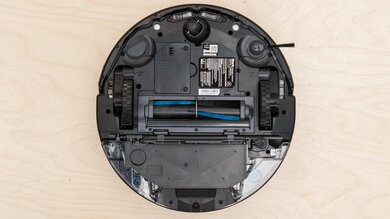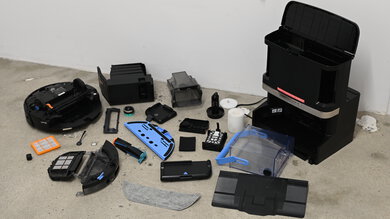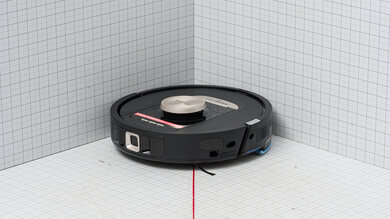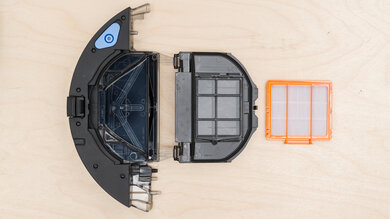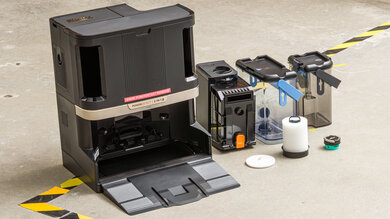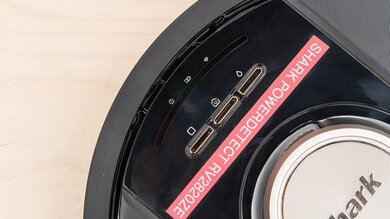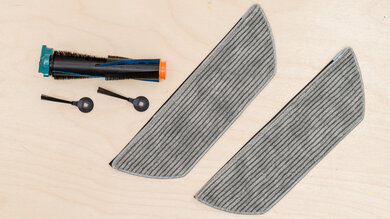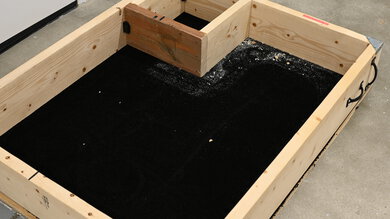The Shark PowerDetect RV2820ZE is a hybrid robot vacuum/mop. It's meant to be the range-topper within Shark's lineup and comes loaded for bear with a ton of features. There's its PowerDetect system, which allows it to adjust its suction and mopping settings depending on a variety of parameters, such as debris and stain concentration, the presence of walls and corners, and the type of surface it's cleaning. This vacuum also comes bundled with a multifunction dock that not only empties the vacuum's internal dustbin but also washes and dries its mopping pad.
The PowerDetect RV2820ZE also boasts a unique edge-cleaning feature that sends puffs of air toward the edges of walls and corners to dislodge any fine debris so that the vacuum can suck it up more easily.
Our Verdict
The Shark PowerDetect RV2820ZE is a reasonable choice for multi-surface household use. It's great on hard floors but lacks the surface agitation necessary to work well on fine debris embedded in carpet fibers, which also makes it struggle with pet hair on carpet. Its obstacle handling is disappointing. It relies on its effective NeverStuck lifting system to prevent it from getting stuck on large obstacles, but its poorly functioning hazard avoidance system means it runs into almost everything, especially on carpet. Its fairly full-featured docking station takes care of most maintenance tasks, though it cleans the mop pad with cold water and dries it with cold air. The mopping system only delivers mediocre performance on stains.
-
Great debris pickup on bare floors.
-
Edge cleaning system works well on bare floors.
-
Good pickup of medium and large debris on carpet.
-
Time consuming periodic maintenance requirements and high recurring costs.
-
Poor pet hair pickup on carpet.
-
Mediocre mopping performance.
-
Ineffective hazard recognition system.
-
Mediocre fine debris-pickup performance on carpets.
The Shark PowerDetect RV2820ZE is a middling option for pet owners. It has a really hard time dealing with pet hair on surfaces like low-pile carpeting and will require multiple passes to deal with large amounts of pet hair. The vacuum itself also does a terrible job of sealing in fine allergens like pet dander while cleaning your home. However, at the very least, its multifunction dock does have a HEPA filter to lock in allergens. There are quite a few parts that you'll need to clean every couple of months, which can be tedious, and the vacuum incurs pretty high costs of ownership.
-
NeverStuck lifting system allows it to climb most obstacles.
-
Time consuming periodic maintenance requirements and high recurring costs.
-
Poor pet hair pickup on carpet.
-
Companion app is limited in overall functionality.
-
Mediocre mopping performance.
The Shark PowerDetect RV2820ZE delivers great debris-pickup performance on hard floors. It easily clears away heavier material without its side brush sending lighter debris scattering everywhere. Its edge-cleaning system also works fairly well.
-
Great debris pickup on bare floors.
-
Edge cleaning system works well on bare floors.
-
Time consuming periodic maintenance requirements and high recurring costs.
The Shark PowerDetect RV2820ZE's debris-pickup performance on carpets is mediocre overall. As with its performance on hard flooring, it does alright with bulky debris, but it doesn't provide much in the way of surface agitation on carpets and struggles with lifting away finer debris that's been worked into carpet fibers. As a result, you might need to run a second pass to deal with bigger messes.
-
Good pickup of medium and large debris on carpet.
-
Time consuming periodic maintenance requirements and high recurring costs.
-
Mediocre fine debris-pickup performance on carpets.
The Shark PowerDetect RV2820ZE delivers poor pet hair pickup performance on surfaces like low-pile carpeting. It lacks the necessary power and surface agitation to lift away hair that's been even lightly pressed into carpet fibers.
-
Time consuming periodic maintenance requirements and high recurring costs.
-
Poor pet hair pickup on carpet.
The Shark PowerDetect RV2820ZE has poor obstacle-handling performance. It does a reasonable job of getting around things like furniture or table legs, but it does tend to bump into furniture pretty hard, so it might be necessary to set up no-go zones around things like mirrors or coat racks. Unfortunately, it does a terrible job of avoiding smaller obstacles like shoes, socks, or loose cables.
-
NeverStuck lifting system allows it to climb most obstacles.
-
Time consuming periodic maintenance requirements and high recurring costs.
-
Ineffective hazard recognition system.
-
Occasionally erratic and inconsistent navigational behavior.
- 6.8 Multi-Surface Household
- 5.5 Pets
Performance Usages
- 8.0 Debris Pickup: Hard Floor
- 6.2 Debris Pickup: Carpet
- 5.0 Debris Pickup: Pet Hair
- 5.4 Obstacle Handling
Changelog
-
Updated Apr 16, 2025:
We've added text to this review for the new tests added in Test Bench 1.0.
- Updated Apr 16, 2025: We've converted this review to Test Bench 1.0, which updates our performance testing to include new tests to evaluate Obstacle Adaptability, Obstacle Avoidance, Height Clearance, and Threshold Clearance. We've also introduced new performance usages. For more information, see our changelog.
- Updated Dec 18, 2024: Review published.
- Updated Nov 18, 2024: Early access published.
- Updated Nov 05, 2024: Our testers have started testing this product.
Check Price
Differences Between Sizes And Variants
The Shark RV2820ZE is available in a single colorway: 'Black/Grey.'
There are also slightly different models in the overall RV2820 lineup, though ultimately they differ only in regards to their base station capabilities.
| Model Name | Base Station Auto-Empty | Base Station Auto-Refill | Base Station Mop Cleaning |
|---|---|---|---|
| RV2820AE | Yes | No | No |
| RV2820YE | Yes | Yes | No |
| RV2820ZE | Yes | Yes | Yes |
We tested the RV2820ZE model, and for those interested, here's the product label.
Let us know in the comments below if you come across another variant of this vacuum.
Compared To Other Robot Vacuums
The Shark PowerDetect RV2820ZE is Shark's flagship robot vacuum. On paper, it seems a match for the majority of upper mid-range models on the market, with a multifunction dock, hazard recognition system, and a bevy of sensors that allow for real-time adjustment of its settings. That said, it falls a bit short in the real world, with mediocre mopping performance and a companion app that's quite rudimentary compared to segment standouts like the Roborock Qrevo S or Dreame L10s Ultra.
If you're looking for alternatives, see our recommendations for the best robot vacuums for hardwood floors, the best budget robot vacuum cleaners, and the best robot vacuums for carpet.
The Roborock Qrevo Pro is a much better robot vacuum than the Shark PowerDetect RV2820ZE. It performs better on all floor types, is much easier to maintain, and has a much better app. Both have mopping capability, but the Roborock does a better mopping job. The Roborock also has better battery life, though you can't replace its battery.
The Roborock Qrevo S is a slightly better robot vacuum than the Shark PowerDetect RV2820ZE. Performance is about the same, but the Roborock is better built and easier to maintain. The Shark's tiny dirt compartment and lower dirt capacity in the dock mean both will fill up more quickly. Also, the very basic SharkClean app can't hope to match the full-featured, excellent Roborock app.
The Roborock S8+/S8 performs better than the Shark PowerDetect RV2820ZE on almost every floor surface. The upgraded Shark dock has more capabilities than Roborock's dock, yet performance is still lacking in comparison to the Roborock vacuum. As well, the Roborock is much easier to maintain, and Roborock's control app is excellent, much better than the very basic SharkClean app.
The Shark PowerDetect RV2820ZE and the Dyson 360 Vis Nav perform remarkably similarly, and are priced similarly with the mop tank filling and mop cleaning dock included with the Shark RV2820ZE. The Shark RV2820 models all add mopping capability, and all docks have dirt self-emptying capability—the Dyson lacks both features. Otherwise they are both fairly mediocre performers, despite the Dyson's huge advantage in suction and airflow.
The Roborock Qrevo is a better robot vacuum than the Shark PowerDetect RV2820ZE, especially for cleaning hard floors. The Roborock is better built and will be easier to maintain. Roborock's excellent app has far more features than Shark's barebones SharkClean app.
Test Results
This vacuum feels decently well-built. Overall, it feels similarly built to the Shark Matrix Plus, with a body made mostly from matte-finish plastic, though there are a few glossy and textured gold plastic accents. Overall, the plastic used in its construction feels cheap, with touchpoints such as the control buttons being an especially egregious example. That said, there aren't too many obvious weak points either, aside from its bumper.
On the upside, the vacuum is easy to assemble and set up, with all parts snapping easily into place. Doing things like pulling out the side brush or removing the brushroll is very simple.
This vacuum is rather demanding in terms of maintenance. In truth, the problem has more to do with the sheer number of parts that need to be washed as opposed to how difficult it is to access and clean them. Everything from the vacuum's brushroll to its dirt compartment and pre-motor filter pop out pretty easily, though there are a few quirks to be mindful of. In testing, we found that once the brushroll had been jammed with pet hair, the vacuum was able to dock with its multifunction recharge station but unable to start the auto-empty process; this was resolved once the brushroll was cleaned. The front wheel also takes a bit of effort to remove.
The same can be said for the NeverTouch Pro base station, which features four different filters, separate water tanks for clean and waste water, a base plate for the mop washing function, and an isolated dirt compartment. All of these parts are easy to remove and clean, with no stubborn latches or hard-to-reach crevices, but they also need to be cleaned periodically. With so many parts, this can be a pretty tedious process.
If you're interested in seeing a full breakdown of the user maintenance requirements associated with this vacuum, you can check out the user manual or watch a set of instructional videos.
This vacuum incurs very high recurring costs, partly due to the added costs associated with its base station.
- Brushroll: The brushroll needs replacing every six to 12 months. Replacements are available online.
- Side brush: The side brush needs to be replaced when it starts to exhibit visible wear and tear. Replacements are available in packs of two.
- Vacuum pre-motor filter: This filter should be replaced every six to 12 months. Replacements are available on Shark's website.
- Mop pad: The mop pad should be replaced every three months. A two-pack of replacements can be purchased on Shark's website.
The NeverTouch Pro base station incurs its own set of costs as well.
- Base station pre-filters: You should swap out the base station's pre-motor filters every six to 12 months. You can buy a set of replacements online.
- Base station post-motor HEPA filter: You should swap out the base station's post-motor HEPA filter every six to 12 months. You can buy a replacement from Shark's website.
- Base station post-motor foam filter: You should swap out the base station's post-motor foam filter every six to 12 months. Replacements are available online.
This vacuum has a tiny internal dustbin, with a debris capacity of only a little more than half that of the Roborock Qrevo, which was already slighted for having a small dustbin. If, for whatever reason, you don't make use of the Shark's auto-empty capability, you should expect to have to empty its dustbin at the end of even small cleaning jobs.
This robot vacuum's NeverTouch Pro dock not only offers a bagless self-empty system but also refills the appliance's internal water tank, washes (or rinses if you don't use the provided cleaning solution) its mop pad, and dries it with cold air. With a 1.80L capacity, the dustbin is advertised as being large enough to hold debris from 60 days worth of cleaning sessions. As for the water tanks, you'll need to refill the clean tank and empty the waste water tank every 30 days. Of course, all of these figures are just advertised estimates and will vary depending on how often you make use of the RV2820ZE's different capabilities.
The base does have an onboard HEPA filter to lock in allergens, though, like any bagless system, emptying out the dustbin can still release a cloud of dust and debris.
The NeverTouch Pro station also has a replaceable cartridge to mask foul odors from its docking station, similar in concept to the one included with manually operated Shark vacuums like the Shark Detect Pro.
- Robot vacuum
- Robot dirt compartment and water tank
- Mop cloth (x2)
- Single-winged side brush (x2)
- Pre-motor foam filter
- Removable mop pad
- Robot pre-motor filter
- Brushroll
- Brushroll cover
- Quick start guide and manual
NeverTouch Pro Base Station
- Base station
- Pre-motor felt filter
- Post-motor HEPA filter
- Post-motor foam filter
- Clean water tank
- Dirty water tank
- Clean water tank cover
- Dirty water tank cover
- Filter holder
- Base dirt compartment
- Base post-motor filter cover
- Odor neutralizer cartridge
- 1x 12oz VacMop cleaning solution bottle
- Base ramp
Since this vacuum lacks any sort of manual power adjustment functionality and instead automatically adjusts to differences in debris concentration and surface type, real-world battery performance can vary drastically depending on the mix of floor types in your home.
This robot vacuum's defining feature is its eponymous PowerDetect system, which automatically adjusts suction power depending on the surface it's on, how close it is to an edge, and the quantity of debris on the ground. If you've enabled the mopping mode, it'll also automatically adjust its mopping intensity to clear away stubborn stains.
This vacuum delivers impressive performance on hard floors. It's ultimately quite effective in handling a wide variety of debris types. That said, a small amount of some larger debris can be left behind. Its edge-cleaning system, which uses bursts of air to dislodge debris in corners, is fairly effective, but a small amount of material might still be left behind.
It's worth noting that this vacuum exhibited inconsistent, haphazard navigational behavior within the confines of our testing box. This erratic movement was echoed in the 'Maneuverability' test within our review. Give us a heads up in the comments below if you also happen to be the owner of a Shark RV2820 model and have experienced a similar issue.
Performance on high-pile carpet is acceptable. The vacuum does a pretty good job of dealing with bulky and medium-sized debris, similar in size to cereal and rice, but it doesn't provide nearly enough surface agitation to clear away finer debris embedded within carpet fibers. Its edge-cleaning system is also far less effective on carpeting than it is on bare floors, and you'll likely have to manually clean any heavily soiled corners.
The vacuum's Dirt Detect system also seems to be partially to blame for some of its inconsistent pathing behavior. Ordinarily, the vacuum would begin a cleaning session in a figure-eight pattern, concentrating most of its attention on heavily soiled areas, but the instant it collides with a wall, it pauses and seemingly never re-targets areas in need of more cleaning.
This vacuum's performance on low-pile carpets is mediocre. It's quite effective in dealing with large debris like cereal, but it has a pretty hard time dealing with anything smaller, especially along walls and in corners. Its Edge Detect system ultimately seems to have little bearing on its performance in this regard.
Since there's no way of selecting the Shark RV2820ZE's suction power setting manually, we were unable to obtain a wholly representative figure for this test. Based on its design and overall performance, we expect its peak airflow to be similar or slightly higher than the older Shark Matrix Plus.
This vacuum is a little on the noisier end for a robovac. Even then, you won't have too much trouble hearing what people nearby are saying, even with the vacuum running nearby.
Since we were unable to manually adjust the vacuum's suction power to measure the 'Low-Pile Carpet' result, we added rice to the surface to engage the Debris Detect function and have the vacuum automatically increase suction.
The multifunction dock is noisier than the vacuum when using the self-empty function, with a peak volume of 70.7 dBA.
This vacuum does a fair job of adapting to obstacles. Its NeverStuck lifting system is a big help here, allowing the vacuum to lift itself away after getting stuck on tasseled rugs and even climb over chair legs. It isn't all upsides, however. Overall pathing is inconsistent and erratic, and the Shark's relatively tall dimensions make it liable to get stuck under some tables, chairs, and couches. It also tends to bump into things like coat racks and mirrors pretty hard, with sufficient force to move them from their initial spot.
The Shark PowerDetect RV2820ZE's obstacle avoidance performance is bad overall. It tends to bump into all manner of obstacles pretty regularly, regardless of whether they're on bare floors or carpeting, though admittedly it does perform worse on the latter. Thinner obstacles like charging cables or socks pose the biggest risk for the vacuum, as it'll frequently run over them and possibly jam the brushroll, forcing you to intervene manually.
This is a tall robot vacuum. Its LIDAR sensor protrudes higher than the norm, and as a result, it's unable to clean under lower TV stands or couches.
This unit's NeverTouch lifting system works very well in allowing the vacuum to cross over a variety of obstacles. To achieve the best possible results, however, you'll need to remove its mopping pad.
Its air filtration performance is poor. The Shark PowerDetect RV2820ZE's post-motor filter isn't HEPA-rated, and fine allergens can easily escape from not only its exhaust but also from the LIDAR sensor and other gaps around its body. That said, its dock does have a HEPA-rated filter.
Its stain-clearing performance is mediocre. It'll take a second pass to have any sort of significant impact on dried-on stains. It's also worth noting that there's little difference in actual stain-clearing performance when using the VacMop cleaning solution compared to having the vacuum clean with just water. Its swing-out mop pad also doesn't reach that far into corners.
The NeverTouch dock station doesn't actually wash the mop pad before a cleaning job. Rather, the RV2820ZE will wiggle in place on the floor to saturate the mop pad. This, in turn, gets your floors pretty wet, which is obviously undesirable if you have a poorly sealed hardwood floor at home.
This vacuum has a few physical automation features. There's the NeverTouch Pro base, which not only empties its dustbin but also refills its water tank and washes and dries its mopping pads, but little else beyond that.
The three buttons atop the vacuum allow you to make some basic commands. Pressing the Dry Clean button allows the vacuum to start a whole-home cleaning run without mopping. Holding it down for a few seconds starts a spot-cleaning cycle for the surrounding area. Pressing the Wet Clean button has it start a whole home cleaning session with the mopping function engaged, while holding it down has it spot-mop an area. There's also a Dock button to send it back to its station, which can also be used to power the device off or toggle the Recharge and Resume functionality.
The SharkClean provides only a satisfactory user experience, offering only basic overall features. It's simply lacking in overall functionality compared to a lot of other apps; there's no multi-floor mapping capability, no remote control, no manual suction adjustment, and no ability to pause or adjust a manual cleaning job once it's been started. You also can't manually begin the mop cleaning or auto-emptying process for the NeverTouch Pro dock. Generated maps are also inaccurate, and the live position of the vacuum within that map tends to be heavily delayed.
Comments
Shark PowerDetect RV2820ZE: Main Discussion
Let us know why you want us to review the product here, or encourage others to vote for this product.
This product has been merged with MSI Katana A15. Follow the discussion here.


